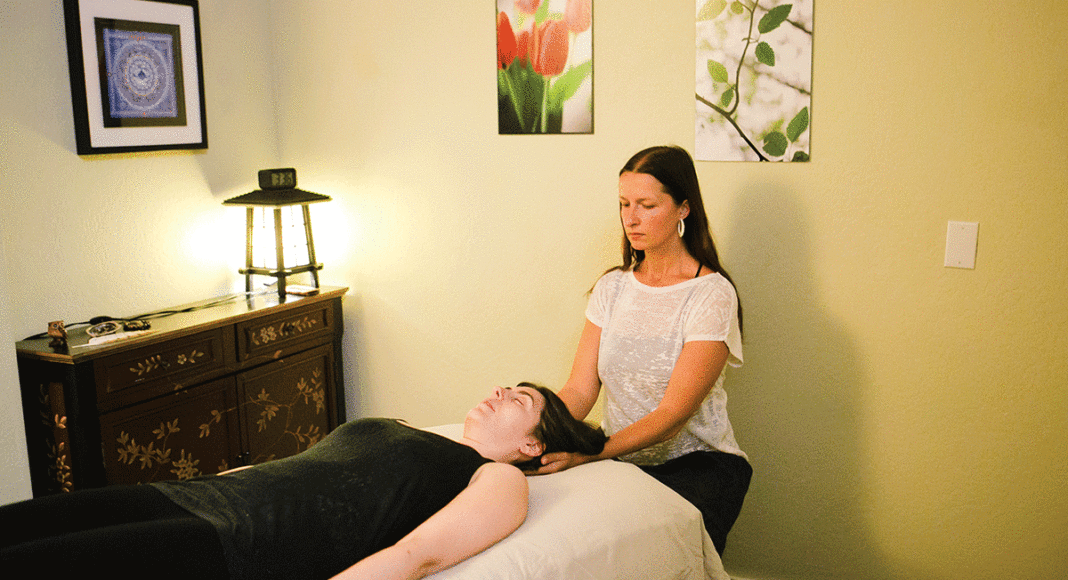Craniosacral therapist Inna Dagman places her hands around my Achilles tendons and heels, and I am immediately aware of how warm her hands are. In less than a minute the room falls away, along with an avalanche of adult worries. It’s safe to say that I spend the rest of my first-ever craniosacral therapy session on the edge of sleep. My breathing slows and my mind, settling into the cushions of hypnagogia, puts its feet up to watch whatever images and thought segments are offered up by the alpha and theta brain waves that have taken over. I’m in my garden, mostly, and then on the rugged coast above Pablo Neruda’s Chilean home Isla Negra—a place I visited more than a decade ago and had not thought about in years.
Starting and finishing at the ankles, Dagman moves her hand placements, in long intervals of gentle pressure, through various points of the spine, neck and head. There are moments of scalp-tingling pleasure, sure, and the feeling of tension melting away, but make no mistake about it: craniosacral therapy is not massage (though Dagman is a certified massage therapist, specializing in Thai floor massage.) It’s more like a nervous system reboot, if you will, with its hands-on healing roots in antiquity.
“There is such a thing as a craniosacral rhythm, which is separate from the breathing rhythm, separate from the heart rate. And that rhythm is the flow of the cerebrospinal fluid throughout the craniosacral system,” says Dagman. Encompassing various membranes and soft tissues, cerebrospinal fluid, and the bony structures of the spine, cranial bones and sacrum, the craniosacral system is the primary system in our body that encases and protects the central nervous system—whose function is vital to our overall health.
Trained at the Upledger Institute, Dagman has been practicing craniosacral therapy for three years now, and working out of the Westside Healing Arts Center for two. Blockages and “energy cysts,” which we can carry around for years, occur when the body encapsulates accumulations of foreign energy or traumas—physical or emotional—to protect itself. “Those areas in our being have a very different quality to the touch of the craniosacral therapist. So we can find them and then we can hopefully release them,” she says.
Dagman was born in Siberia, where, if a healer was called to a rich household and a poor one simultaneously, the healer would attend to the poorer one first. With that ethos, she often shares her gift for healing pro-bono. Among others, she’s worked with women at the Walnut Avenue Women’s Center who have experienced abusive relationships and addiction cycles, and she traveled to India in 2015 with the nonprofit New Light India to share craniosacral therapy as well as belly dance instruction with women and girls in forced sex work. Her dream next step is to bring craniosacral therapy into prisons.
Dagman sees the body, mind and spirit as inseparable. And while she’s passionate about the modality’s potential for healing spiritual and emotional traumas‚ traversing those realms depends fully on the intent of the client, she says. While craniosacral therapy can address a variety of symptoms and conditions, including pain brought by injury, surgery, and the accumulated stresses of modern day life, it’s also a valuable way to stay healthy, as it nudges the body into a self-healing state. “As practitioner, I guide you, but I am not the one doing it. It is your own wisdom that leads the session, your own innate doctor,” she says.
Placebo or not, the days following my first session are marked by a shift in perception. In an acupuncture appointment the day after, I drop into a relaxed dream state of rest much quicker than normal—and Dagman explains that acupuncture and craniosacral therapy are a common combination. “Because acupuncture works with our energy system,” says Dagman. “Craniosacral therapy in a way makes our energy system more accessible, more open, more ready, so then the acupuncture can be even more potent.”
For those on a healing path, this gentle yet effective technique works well in conjunction with other healing modalities, including talk therapy and other forms of bodywork. “Every human being is perfect wherever they are on their unique journey,” says Dagman. “I’m just there to meet them and see what is there to release. With love—it’s not a personal love, but a complete lack of judgement, complete presence.”
For more information on Inna Dagman’s work, visit wildcreekhealingarts.com.














The Good Times editors have a long history of promoting these sort of pseudoscientific ideas about health. This stuff is in the same realm as creationism and global warming denial. Why don’t we see articles about the real miracles that are being practiced by medical professionals in our local hospitals?
Nicely written. Thanks for sharing your experience!
Full Body Health Care Products. click here to get started!